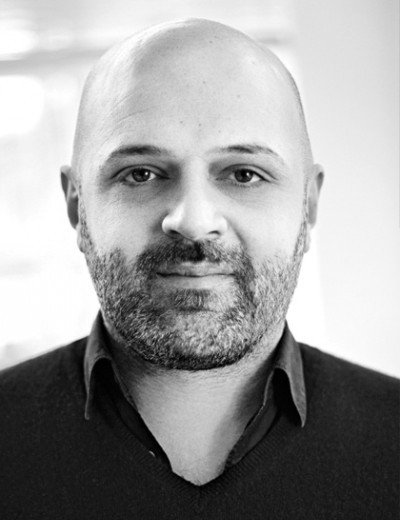
Hussein Chalayan
About
the designers
Hussein Chalayan is a Turkish Cypriot, born in 1970. His name was originally Huseyin Caglayan but he changed it to Chalayan. He was an only child, his parent separated, his mother remaining in Cyprus and his father going to London. Hussein joined him there in 1982 when he was 12 years old. His father, whose name is Ata, has since remarried.
Chalayan did not consider designing clothes initially; he wanted to be a pilot or an architect. He very nearly studied architecture but changed his mind at the last minute and joined St. Martins School of Art, London. His degree show in 1993, was received with elation
It was displayed in the windows, by Browns, the store which has started so many young designers including John Galliano. His collection was made with fabric which he had buried in the garden with steel filings to give an aged look. He had tried to put magnets on the catwalk to pull out steel rods in the garments, but it didn't work. Even though it was a radical design, the collection had commercial pieces which sold immediately.
In 1994, he presented his first solo collection.
In 1995, he used illuminated airport in-flight path patterns on his garments. In the same year he topped 100 rivals to win a contest organized by Absolut Vodka, who backed him financially for London Fashion Week.
In 1997, he used extensive beading executed with mathematical precision, on his dresses. The eveningwear was in the form of column dresses in fine matt jersey, decorated with jet beads, gold embroidery and gold chains.
In 1998, Chalayan was honoured with the Designer of the Year award at the annual British Fashion Awards. He is admired by all the leading avant-garde designers. Rei Kawakubo says "I like his attitude and way of thinking." Alexander McQueen says "I admire his challenging mind."
Chalayan has displayed an uncanny ability to present spot-on collections season after season. Some collections shock people, such as his "Between" collection of 1998. He presented traditional Muslim garb combined with half-naked models parading down the catwalk.
Chalayan has developed a reputation for being a serious man of ideas, who avoids fashions social circuit like the plague. His work is highly individual, he avoids borrowing from fashion history as so many designers do. For several seasons he cut clothes without armholes or sleeves, binding the arms close to the body but he says "I just did it for the shows, I don't expect people to actually wear them like that."
In addition to his own label, he also designed for 3 years for TSE in New York, and has created a new outlet TOP SHOP in London.
In 2000, he was voted British Fashion Designer of the year. However financial troubles came in his way in 2001 and he had to close down his company for several months.
He became Creative Director of Asprey, Britain's venerable lifestyle brand.
However in December 2001 he has entered into partnership with Gibo Co. Spa, who has become the worldwide licensee for his ready-to-wear label. Chalayan is currently showing in Paris, not London.
Asprey had not tackled womenswear since the 1920's but appointed Hussein Chalayan in 2000 to create ready-to-wear. Britain's hottest new beauty, Keira Knightly, has been Asprey's new "face". Chalayan said "I want to make luxury clothing ultra-functional, in keeping with British tradition, but timeless and appealing to anyone who really loves design." However, after completing four years, Hussein has now left Asprey to concentrate on his own label exclusively.
In August 2004, Chalayan announced he is launching a new line. He opened his first store in Tokyo in April 2004 which is going well. He is now expanding his women's line to sell at 40% lower prices than his signature collection. Gibo, the Italian firm, will produce the new line as well as Chalayan's main line. Franco Pene, chairman of Gibo said "this is a very commercial collection, where the designer can freely express his creativity, and reach a new younger market." He can experiment with ideas which may be a bit radical for his more expensive line.
A passionate fashion designer, Chalayan has made his feelings for celebrity-based fashion clear when he publicly announced how he felt about Kate Moss's collaboration with high-street clothing label Top Shop, calling the move "insulting".
Collaborations do not stop with art and fashion for the designer, who is also a philanthropist. In 2007, he donated a showpiece to the Fashion is Art exhibition in aid of radio station Capital 95.8's Help a London Child charity which was sold at an exclusive auction in London.
In early 2008, he designed a series of laser LED dresses in collaboration with luxury label Swarovski, showcased in Tokyo. 28th February 2008, Chalayan was appointed as the creative director for German sportswear label Puma. Puma have also announced that they have purchased a majority stake in his label. The designer also collaborated with German hoisery and legwear label Flake to produce one-off footwear pieces for his Autumn/Winter 2008 collection show cased in Paris
The Look
His clothes are minimal in look, maximal in thought. His work challenges what you can do with a length of fabric. He rethinks the body and challenges the concept of zones of the body. He tries never to make his clothes sexy. He does not want them to be attractive in that obvious way. He uses a lean sinuous silhouette, great attention to detail and fabrics liked felted wools, double-faced cashmere, and matt jersey. There is often a darkness to his themes, vampires, tombs and constriction have all featured in his collections. However, overall his clothes are innovative, exquisite and technically brilliant. They are high-concept pieces encapsulating the pure beauty of femininity.